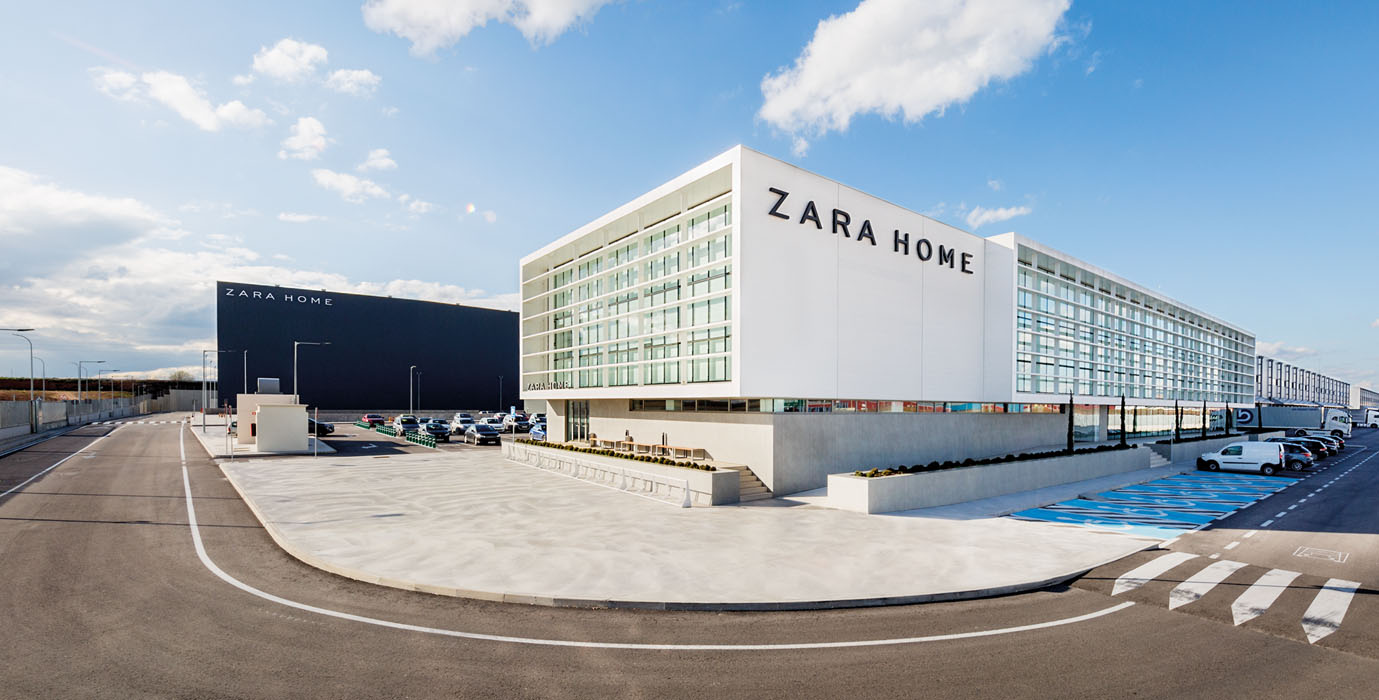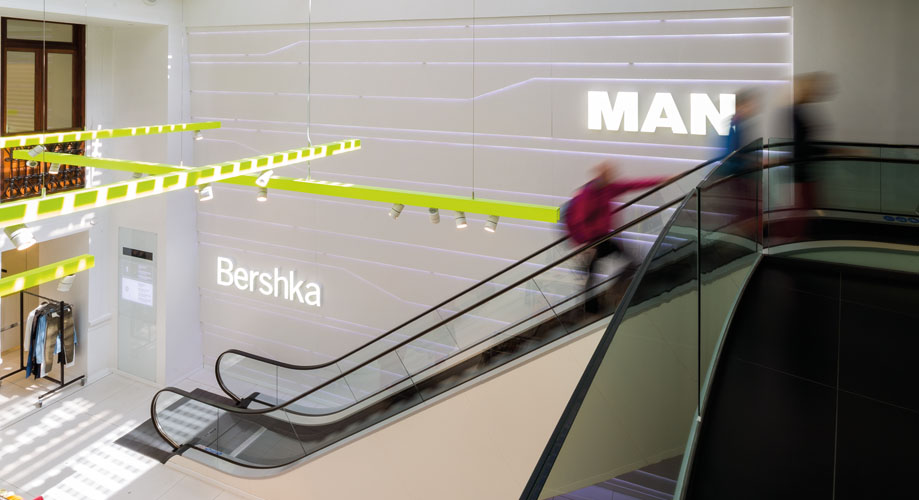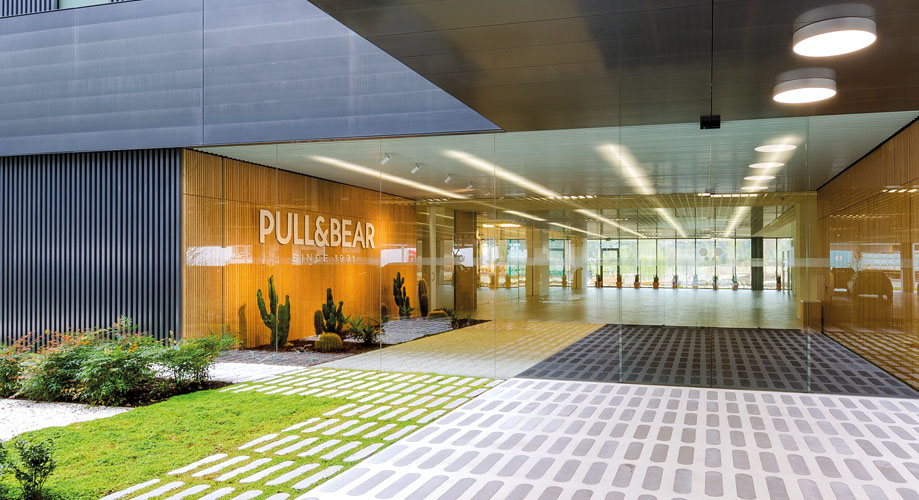Environmental Management in head offices and stores
The efficient use of resources is essential to sustainable development and the protection of the environment. Along with sustainable manufacturing, which is discussed in the chapter Maximum Product Quality, it is the central axis of our strategic environmental plans. Our strategies in the field of environmental sustainability allow us to manage our resources at all stages of the value chain in a rational manner.
As a result of advances in efficiency and environmental sustainability made during the 2011-2015 plan, by 2015 we succeeded in reducing the relative power consumption per item of our logistics centres, offices and Inditex factories by 4%. In addition, we have reduced the relative electricity consumption per item in stores by 12% as a result of the consolidation of the measures defined in the eco-efficient store manual.
To ensure that our items leave the smallest carbon footprint possible, we continue to improve energy efficiency and the reduction of emissions at the logistic centres, stores and offices of Inditex and its brands. The year 2015 has seen several milestones for the Group such as the implementation of maximum energy-efficient facilities, including the expansion of the Inditex logistics centre in Cabanillas (Guadalajara), the renovation of the Pull&Bear corporate head office in Narón (A Coruña) and the opening of 330 eco-efficient stores.
Logistics platforms and offices
The environmental management of our logistics platforms was certified ISO 14001 compliant, which reflects efficiency and proper operation. In addition, we promote the purchase of green energy and are committed to the generation of renewable energy at our facilities. In 2015 alone, we generated more than 47 million kWh of renewable energy at our logistics centres.
During that year, an Efficiency Plan was launched at logistics centres and offices with the objective of reducing the energy consumption and improving the efficiency of the facilities. In 2015 we began to replace fluorescent lighting with high-efficiency LED bulbs, which led to energy savings in lighting.
Finally, for improved emissions control, we developed a tool that calculates emissions resulting from shipments made, in line with the GHG Protocol.
The training and awareness of employees is critical not only to the environmental plan, the latest of which is working towards deliverables for 2020. But also we have a Manual of Good Environmental Practices, for corporate head offices and subsidiary offices, which has become a standard for environmental management and performance, and which includes daily actions and activities that, when implemented, reduce the impact generated at the facilities.
We have also increased the number of programmes and hours devoted to environmental training aimed at our employees in logistics centres and international offices.
Green logistics: Green to Pack
In 2015 we continued to make progress on reducing energy consumption and emissions from power generation, taking actions throughout the value chain. By ensuring that at least half of our production is in close proximity to our head offices and logistics centres, all located in Spain, we managed to significantly reduce the energy consumed in shipments to stores. In addition, transport has been improved through the development of sustainable logistics measures, including the launch of the Green to Pack programme, the main objective of which is to optimize the packaging used throughout the supply chain, progressing towards our zero waste to landfill goal.
The packaging involved in logistics activities plays an important part in our waste generation. Green to Pack is a programme that actively involves both product and logistics service suppliers. With these suppliers, we have homogenized and standardized packaging material in order to reduce the consumption of raw materials and improve shipment density, increasing the amount of products transported in each shipment. Additionally, the use of more sustainable materials in our packaging was encouraged, improving re-use in multiple shipments and its subsequent separation and recycling.
Implementing the measures included in the Green to Pack programme allowed us to save using 660 containers in maritime distribution and, thanks to improved land transport planning, avoid 2,300,000 kilometres of transport and their associated emissions. In addition, plans for improving shipment density were completed, avoiding the use of 185,700 m2 of cardboard.
Complementing these shipment density improvement plans, the measures contained in the Zara packaging guidelines define the specifications for optimal product packaging and distribution for our suppliers. In our stores, the Waste Minimization Plan has been implemented. This plan, together with the In-Store Waste Management Manual, allows us to combine efforts and reduce the amount of relative waste generated. In 2015, the reuse of boxes, hangers and alarms in the shipment of our garments resulted in the reuse of 815 million alarms and resulted in the reuse of 87 million plastic hangers. When hangers are broken they are recycled, reducing waste generation and actively promoting a circular economy.

Environmental Commitment to China
One of the first regional environmental programmes included in the new 2016-2020 Plan will be implemented in China. Inditex has made a specific commitment to the Chinese Ministry of the Environment that by 2018, two years before the global Group objective, all stores in this market will be eco-efficient, incorporating the most advanced technologies in order to reduce their environmental impact and greenhouse gas emissions.
Also in China, Inditex will implement a specific environmental control project in the supply chain, supporting the Ministry and the Institute of Public & Environmental Affairs (IPE) in its enforcement of environmental legislation, by improving water quality, evaluating zero discharge compliance and ensuring proper waste management. Our teams will continue to work with strategic suppliers to improve their environmental performance and transparency through disclosure of their impact.
Employee training in environmental sustainability
At Inditex, we have developed training projects in order to ensure that environmental sustainability is implemented in all of our activities, with the objective that all of us at Inditex demonstrate exemplary behaviour with respect to the environment.
In recent years, training has been given both at the logistics centres and at the stores, promoting effective behaviour and responsible practices. Through workshops focused on the Logistics Centre Zero Waste to Landfill objective, logistics platform and store employees have received training on the Group’s sustainability strategy, the importance of proper waste management and eco-efficient stores. Training in environmental sustainability has also been given at the Group’s corporate head offices and international offices, based on the specific needs of each department or work area.

Eco-efficient stores: Objective 100% by 2020
At the end of 2015, we had 3,778 eco-efficient stores, some 54% of the Group’s network of stores. We continue to pursue the goal of ensuring all stores are eco-efficient by 2020. An eco-efficient Inditex store reduces electricity consumption by up to 20% and saves up to 50% on water consumption compared with a conventional store.
The Eco-Efficient Store Manual describes all the actions and technical requirements facilities must comply with if they are to meet our efficiency and environmental sustainability requirements for construction (electrical installation, HVAC, plumbing, lighting, materials, furniture), as well as the operations carried out at the facilities, such as waste management. The majority of the electricity savings are found in the HVAC systems, which produce average estimated savings of 40%, with the additional reduction in greenhouse gas emissions.
Stores constructed before 2007 will be renovated in order to comply with the parameters defined in the Eco-Efficient Store Manual. In 2015, under these eco-efficiency parameters, flagship stores such as Zara ,on Place du Molard (Geneva), and Oysho, on Paseo de Gracia (Barcelona) were renovated, among others. These two stores will obtain LEED Gold certification next year.
In order to maintain the 2020 objective, we have an efficiency platform that centrally monitors the stores’ HVAC and electricity installations. This centralized control allows the installations to be adjusted, to optimize their management, identify the most efficient systems, improve their maintenance and define strategies to decrease energy demand and reduce greenhouse gas emissions produced by our stores. We now have a total of 1,444 stores in 28 countries connected to the central efficiency platform.
All forest products used in our stores have sustainable forest certification. All furniture and paper products such as paper bags and labels used in our activities have PEFC or FSC seals, guaranteeing that the entire process of forest-based raw material management is operated in a sustainable and controlled manner.
Additionally, in the different markets in which Inditex has a commercial presence, specific actions have been taken designed to improve efficiency. An example of this is the purchase of renewable energy by our stores located in Germany, totalling 47 million kWh, avoiding the greenhouse gas emissions associated with fossil fuels.
The Eco-Efficient Store Manual is updated constantly with the most innovative technologies for commercial use in the field of eco-efficiency and it includes best practices in environmental sustainability. In order to ensure that our Eco-Efficient Store Manual complies with the most up-to-date sustainability and efficiency requirements, we continue to certify some flagship stores under the LEED and Bream seals of sustainable construction, two of the most prestigious standards in the world. As of the end of 2015, we had 20 flagship stores certified to the LEED sustainable construction standard (Gold and Platinum) and six logistics centres or head offices with this seal. Three of our stores are currently in the process of certification: Zara, Karl Johansgate (Oslo); Zara, SoHo (New York); Zara, rue Halévy (Paris).

LEED and BREAM certified stores, logistics centres and headquarters worldwide
| LEED PLATINUM / GOLD | LEED PLANNED | BREAM | |
|---|---|---|---|
| EUROPA | |||
| Zara, Via del Corso, Rome | |||
| Zara, Serrano, Madrid | |||
| Zara, Oxford St, London | |||
| Pull&Bear, Lijnbaan, Rotterdam | |||
| Bershka, Tauentzienstrasse, Berlin | |||
| Bershka, Colón, Valencia | |||
| Zara Portal de l´Angel, Barcelona | |||
| Zara, Champs Elysées, Paris | |||
| Zara, Kalverstraat, Amsterdam | |||
| Zara Haas Haus, Vienna | |||
| Zara, Rynek Glowny, Krakow | |||
| Zara Home, Champs Elysées, Paris | |||
| Zara Home, Fürstenfelder, Munich | |||
| Pull&Bear, Gran Vía, Madrid | |||
| Massimo Dutti, Serrano, Madrid | |||
| Massimo Dutti, Palma de Mallorca | |||
| Massimo Dutti, San Feliu, Palma de Mallorca | |||
| Massimo Dutti Logistic Centre, Tordera | |||
| Inditex Technological Centre, Arteixo | |||
| Cabanillas Logistic Centre, Guadalajara | |||
| Massimo Dutti Offices, Tordera | |||
| Inditex Head Offices, Arteixo | |||
| Pull&Bear Offices, Narón, A Coruña | |||
| Zara, Place du Molard, Geneva | |||
| Zara Karl Johansgate, Oslo | |||
| Zara Halévy, Paris | |||
| Oysho Paseo de Gracia, Barcelona | |||
| Oysho Rivoli, Paris | |||
| Tempe Technological Centre, Elche | |||
| ASIA AND THE REST OF THE WORLD | |||
| Zara West Nanjing Road, Shanghai | |||
| Zara Bourke, Melbourne | |||
| AMERICA | |||
| Zara Madero, Mexico | |||
| Zara SoHo, New York |
